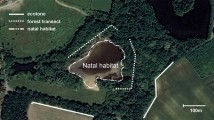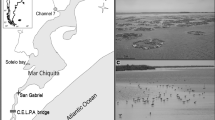Abstract
Effective habitat management is predicted to have positive effects on populations and species of conservation concern. Although studies have shown that ecological processes such as colonization can be promoted after habitat management, we still need more information on the survival and reproductive consequences at the individual level in order to reach positive conservation outcome. Here we assess the effects of reproductive habitat supplementation (host oviposition plant) on survival and mating success of an endangered endemic damselfly, Calopteryx exul, using capture-mark-recapture data. We first determined that the species prefer to oviposit on floating leaves of Potamogeton spp. Based on Cormack-Jolly-Seber modeling, we found that recapture and survival probabilities were positively affected by the number of the host oviposition patches of the host plant. Moreover, we showed a strong positive relationship between adult lifespan and lifetime mating success. Our results suggest that host-plant provisioning for reproduction not only increases the survival of individuals, but also increases the number of matings per lifetime. The procedure of supplying reproductive sites may enhance population growth of threatened odonates and other aquatic insects.






Similar content being viewed by others
References
Akçakaya HR, Bennett EL, Brooks TM, Grace MK, Heath A, Hedges S, Hilton-Taylor C, Hoffmann M, Keith DA, Long B (2018) Quantifying species recovery and conservation success to develop an IUCN Green List of Species. In: Burgman MA (ed) Conservation biology. Wiley, Hoboken
Amstrup SC, McDonald TL, Manly BF (2010) Handbook of capture-recapture analysis. Princeton University Press, Princeton
Andersen E, Nilsson B, Sahlén G (2016) Survival possibilities of the dragonfly Aeshna viridis (Insecta, Odonata) in southern Sweden predicted from dispersal possibilities. J Insect Conserv 20:179–188
Ayllón D, Almodóvar A, Nicola GG, Parra I, Elvira B (2012) Modelling carrying capacity dynamics for the conservation and management of territorial salmonids. Fish Res 134:95–103
Banks MJ, Thompson DJ (1987) Lifetime reproductive success of females of the damselfly Coenagrion puella. J Anim Ecol 56:815–832
Biggs J, Williams P, Whitfield M, Nicolet P, Weatherby A (2005) 15 years of pond assessment in Britain: results and lessons learned from the work of Pond Conservation. Aquat Conserv 15:693–714
Birch LC (1948) The intrinsic rate of natural increase of an insect population. J Anim Ecol 17(1):15–26
Bonte D, Van Dyck H, Bullock JM, Coulon A, Delgado M, Gibbs M, Lehouck V, Matthysen E, Mustin K, Saastamoinen M (2012) Costs of dispersal. Biol Rev 87:290–312
Bowler DE, Benton TG (2005) Causes and consequences of animal dispersal strategies: relating individual behaviour to spatial dynamics. Biol Rev 80:205–225
Byers CJ, Eason PK (2009) Conspecifics and their posture influence site choice and oviposition in the damselfly Argia moesta. Ethology 115:721–730
Chaput-Bardy A, Grégoire A, Baguette M, Pagano A, Secondi J (2010) Condition and phenotype-dependent dispersal in a damselfly, Calopteryx splendens. PLoS ONE 5:e10694
Corbet P (1999) Dragonflies: behaviour and ecology of Odonata. Harley Books, Colchester
Cordero-Rivera A, Stoks R (2008) Mark-recapture studies and demography. In: Córdoba-Aguilar A (ed) Dragonflies and damselflies: model organisms for ecological and evolutionary research. Oxford University Press, Oxford, pp 7–20
Córdoba-Aguilar A (2008) Dragonflies and Damselflies: model organisms for ecological and evolutionary research. Oxford University press, Oxford
Crowley P, Nisbet R, Gurney W, Lawton J (1987) Population regulation in animals with complex life-histories: formulation and analysis of a damselfly model. In: Advances in ecological research, vol 17. Elsevier, New York, pp 1–59
Darwall W, Smith K, Allen D, Holland R, Harrison I, Brooks E (2011) The diversity of life in African freshwaters: underwater, under threat: an analysis of the status and distribution of freshwater species throughout mainland Africa. The diversity of life in African freshwaters: underwater, under threat: an analysis of the status and distribution of freshwater species throughout mainland Africa
Díaz S, Fargione J, Chapin FS III, Tilman D (2006) Biodiversity loss threatens human well-being. PLoS Biol 4:e277
Dudgeon D, Arthington AH, Gessner MO, Kawabata Z-I, Knowler DJ, Lévêque C, Naiman RJ, Prieur-Richard A-H, Soto D, Stiassny ML (2006) Freshwater biodiversity: importance, threats, status and conservation challenges. Biol Rev 81:163–182
Galewski T, Collen B, McRae L, Loh J, Grillas P, Gauthier-Clerc M, Devictor V (2011) Long-term trends in the abundance of Mediterranean wetland vertebrates: from global recovery to localized declines. Biol Conserv 144:1392–1399
Goertzen D, Suhling F (2013) Promoting dragonfly diversity in cities: major determinants and implications for urban pond design. J Insect Conserv 17:399–409
Hassall C, Hollinshead J, Hull A (2011) Environmental correlates of plant and invertebrate species richness in ponds. Biodivers Conserv 20:3189–3222
Kalkman VJ, Clausnitzer V, Dijkstra K-DB, Orr AG, Paulson DR, van Tol J (2008) Global diversity of dragonflies (Odonata) in freshwater. Hydrobiologia 595:351–363
Khelifa R (2013) Flight period, apparent sex ratio and habitat preferences of the Maghribian endemic Calopteryx exul Selys. Zygoptera, Odonata, p 1853
Khelifa R, Mellal MK (2017) Host-plant-based restoration as a potential tool to improve conservation status of odonate specialists. Insect Conserv Divers 10.2:151–160. https://doi.org/10.1111/icad.12212
Khelifa R, Zebsa R, Amari H, Mellal MK, Mahdjoub H, Kahalerras A (2016) A hotspot for threatened Mediterranean odonates in the Seybouse River (Northeast Algeria): are IUCN population sizes drastically underestimated? Int J Odonatol 19:1–11
Laake J (2013) RMark: an R Interface for Analysis of Capture–Recapture Data with MARK, AFSC Processed Rep 2013-01. Alaska Fish Sci Cent, NOAA, National Marine Fisheries Service, Seattle, Washington
Lambret P, Besnard A, Matushkina N (2015) Initial preference for plant species and state during oviposition site selection by an odonate. Entomol Sci 18:377–382
Lucena-Moya P, Duggan IC (2011) Macrophyte architecture affects the abundance and diversity of littoral microfauna. Aquat Ecol 45:279–287
Martens A (1993) Influence of conspecifics and plant structures on oviposition site selection in Pyrrhosoma nymphula (Sulzer)(Zygoptera: Coenagrionidae). Odonatologica 22:487–494
Martens A (1994) Field experiments on aggregation behaviour and oviposition in Coenagrion puella (L.)(Zygoptera: Coenagrionidae). Adv Odonatol 6:49–58
Martens A (2001) Initial preference of oviposition sites: discrimination between living and dead plant material in Sympecma fusca and Coenagrion caerulescens (Odonata: Lestidae, Coenagrionidae). Eur J Entomol 98:121–123
Martens A, Rehfeldt G (1989) Female aggregation in Platycypha caligata (Odonata: Chlorocyphidae): a tactic to evade male interference during oviposition. Anim Behav 38:369–374
Matushkina N, Gorb S (2007) Mechanical properties of the endophytic ovipositor in damselflies (Zygoptera, Odonata) and their oviposition substrates. Zoology 110:167–175
Matushkina N, Lambret P, Gorb S (2016) Keeping the golden mean: plant stiffness and anatomy as proximal factors driving endophytic oviposition site selection in a dragonfly. Zoology 119:474–480
Plaistow S, Siva-Jothy MT (1996) Energetic constraints and male mate-securing tactics in the damselfly Calopteryx splendens xanthostoma (Charpentier). Proc R Soc Lond B 263:1233–1239
Rodríguez-Muñoz R, Bretman A, Slate J, Walling C, Tregenza T (2010) Natural and sexual selection in a wild insect population. Science 328:1269–1272
Sanderson EW (2006) How many animals do we want to save? The many ways of setting population target levels for conservation. Bioscience 56:911–922
Sibly RM, Barker D, Denham MC, Hone J, Pagel M (2005) On the regulation of populations of mammals, birds, fish, and insects. Science 309:607–610
Stettmer C (1996) Colonisation and dispersal patterns of banded (Calopteryx splendens) and beautiful demoiselles (C. virgo)(Odonata: Calopterygidae) in south-east German streams. Eur J Entomol 93:579–593
Strayer DL, Dudgeon D (2010) Freshwater biodiversity conservation: recent progress and future challenges. J N Am Benthol Soc 29:344–358
Thomaz SM, Cunha ERd (2010) The role of macrophytes in habitat structuring in aquatic ecosystems: methods of measurement, causes and consequences on animal assemblages’ composition and biodiversity. Acta Limnol Bras 22:218–236
Thompson DJ (1990) The effects of survival and weather on lifetime egg production in a model damselfly. Ecol Entomol 15:455–462
Acknowledgements
We are thankful to the reviewers for their constructive comments.
Author information
Authors and Affiliations
Corresponding author
Ethics declarations
Conflict of interest
The authors confirm that there is no conflict of interest in case of the manuscript. In addition, the authors have declared that no competing interests exist.
Electronic supplementary material
Below is the link to the electronic supplementary material.
10841_2018_85_MOESM1_ESM.tif
Fig. S1. Temporal pattern of the number of oviposition patches of Potamogeton spp in the capture-mark-recapture study site (TIF 205 KB)
Rights and permissions
About this article
Cite this article
Mellal, M.K., Bensouilah, M., Houhamdi, M. et al. Reproductive habitat provisioning promotes survival and reproduction of the endangered endemic damselfly Calopteryx exul. J Insect Conserv 22, 563–570 (2018). https://doi.org/10.1007/s10841-018-0085-5
Received:
Accepted:
Published:
Issue Date:
DOI: https://doi.org/10.1007/s10841-018-0085-5




